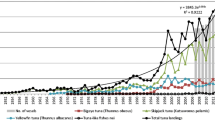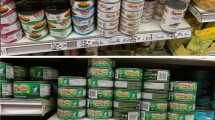Abstract
Purpose
The skin and other residues that arise from the production of tilapia fillets can be used as feedstock for gelatin extraction. To derive maximum benefit from these residues, two gelatin extraction processes were developed at the laboratory scale: process A that used Nile tilapia skin as feedstock and process B that used residues from the extraction of mechanically separated tilapia meat. This study initially evaluates the environmental impact of these two extraction processes at the laboratory stage to determine the relative impacts of each one. Scenario analysis is performed for the choices available at the laboratory stage, regarding the use of reagents. Furthermore, the laboratory process with the lowest environmental impacts is scaled to a pilot plant and its performance evaluated.
Methods
The ReCiPe midpoint method was applied to evaluate the categories of climate change, ozone depletion, terrestrial acidification, freshwater eutrophication, marine eutrophication, photochemical oxidant formation, particulate matter formation, ionizing radiation, water depletion, metal depletion, and fossil depletion. The categories of freshwater ecotoxicity and carcinogenic and non-carcinogenic human toxicity were assessed using the USEtox model.
Results and discussion
Results show that the production of gelatin from process A was less environmentally burdened than that from process B, among all impact categories. The scenario analysis shows that the replacement of some reagents reduced the environmental burdens of gelatin in both processes, but process A still performed better than process B did. The up scaling of process A revealed that impacts mainly resulted from the energy used for drying the gelatin solution and the use of resin and activated carbon for deionization and deodorization of the gelatin. This study argues that despite the challenges of applying life cycle assessment from early research stages, results from these efforts allow a search for alternatives at an early research stage that are both viable at the pilot stage, in terms of equipment requirements, and would lead to lower environmental impacts. Without such analyses, new developments may be a scientific breakthrough but will not evolve from the laboratory to the industrial scale.
Conclusions
The main contribution of this work is the determination of an environmentally sound technological route for gelatin obtained from tilapia residues. According to the performed analysis, the production of gelatin from tilapia residues at the pilot scale should use skin as a raw material. A research agenda is presented to improve further the sustainability of process A.






Similar content being viewed by others
References
ACEB (Brazilian Cultural and Educational Association) (2014) Brazilian aquaculture and fishery yearbook. ACEB, Florianópolis
APHA, AWWA, and WEF (American Public Health Association, American Water Works Association, and Water Environment Federation) (2005) Standard methods for the examination of water and wastewater, 21st edn. American Public Health Association, Washington, DC
BEB (Brazilian Energy Balance) (2015) Year 2014/Energy Research Company. EPE, Rio de Janeiro
Blonk Agri-footprint BV (2014) Agri-Footprint—part 2—description of data—version 1.0. Blonk Agri-footprint BV, Gouda
Brentner LB, Eckelman MJ, Zimmerman JB (2011) Combinatorial life cycle assessment to inform process design of industrial production of algal biodiesel. Environ Sci Technol 45:7060–7067
Bueno CM, Alvim ID, Koberstein TCRD, Portella MC, Grosso C (2011) Production of tilapia skin gelatin and its use in the production of micro-particles containing salmon oil. Braz J Food Technol 14(1):65–73
Baumann H, Tillman AM (2004) The hitch hiker’s guide to LCA: an orientation in life cycle assessment methodology and application. Studentlitteratur, Lund
Cerutti AK, Bruun S, Beccaro GL, Bounous G (2011) A review of studies applying environmental impact assessment methods on fruit production systems. J Environ Manag 92(10):2277–2286
De Menna F, Vittuari M, Molari G (2015) Impact evaluation of integrated food-bioenergy systems: a comparative LCA of peach nectar. Biomass Bioenerg 73:48–61
EPE (Empresa de Pesquisa Energética) (2015) Brazilian energy balance 2015—year 2014. Empresa de Pesquisa Energética: EPE, Rio de Janeiro
FAO (Food and Agriculture Organization of the United Nations) (2014) The state of world fisheries and aquaculture. FAO, Rome
Fréon P, Bouchon M, Domalain G, Estrella C, Iriarte F, Lazard J, Legendre M, Quispe I, Mendo T, Moreau Y, Nuñez J, Sueiro JC, Tam J, Tyedmers P, Voisin S (2010) Impacts of the Peruvian anchoveta supply chains: from wild fish in the water to protein on the plate. Globec International Newsletter 16:27–31
Gavankar S, Suh S, Keller AA (2014) The role of scale and technology maturity in life cycle assessment of emerging technologies: a case study on carbon nanotubes. J Ind Ecol 19(1):51–60
Goedkoop M, Heijungs R, Huijbregts MAJ, De Schryver A, Van Zelm R (2009) ReCiPe 2008: a life cycle impact assessment method which comprises harmonised category indicators at the midpoint and the endpoint level. PRé Consultants, University of Leiden, Radboud University (CML) and National Institute for Public Health and the Environment (RIVM), the Netherlands
Goedkoop M, Oele M, Leijting J, Ponsioen T, Meijer E (2013) Simapro8: introduction to LCA with SimaPro. PRé-Consultants, the Netherlands
Hall GM (2011) Fishmeal production and sustainability. IN: Hall GM (ed) Fish processing sustainability and new opportunities. Wiley, Blackwell Publishing Ltd.
Heijungs R, Lenzen M (2014) Error propagation methods for LCA—a comparison. Int J Life Cycle Assess 19:1445–1461
Hetherington AC, Borrion AL, Griffiths OG, McManus MC (2014) Use of LCA as a development tool within early research: challenges and issues across different sectors. Int J Life Cycle Assess 19:130–143
ISO (International Organization for Standardization) (2006a) ISO 14040:2006—environmental management—life cycle assessment—principles and framework. ISO, Geneva
ISO (International Organization for Standardization) (2006b) ISO 14044:2006—environmental management—life cycle assessment—requirements and guidelines. ISO, Geneva
Johnston-Banks FA (1990) Gelatine. In: Harris P (ed) Food gels. Elsevier, London, pp. 233–289
Kittiphattanabawon P, Benjakul S, Visessanguan W, Shahidi F (2010) Comparative study on characteristics of gelatin from the skins of brownbanded bamboo shark and blacktip shark as affected by extraction conditions. Food Hydrocoll 24(2–3):164–171
Leonhardt JH, Caetano Filho M, Frossard H, Moreno AM (2006) Morphometrics, fillet yield and fillet composition in Nile tilapia, Oreochromis niloticus, strains thai chitralada, Brazil local and their hybrid. Semina: Ciências Agrárias 27(1):125–132
Morais JPS, Claudino RL, Figueirêdo MCB, Sampaio APC, Melo EF, Souza Filho MSM, Rodrigues MLL, Figueiredo MCA, Rosa MF (2013) Balanço de massa da carne mecanicamente processada de tilápia [mass balance in getting mechanically separated meat (MSM) of tilápia]. Embrapa Agroindústria Tropical, Fortaleza
Nagarajan M, Benjakul S, Prodpran T, Songtipya P, Kishimura H (2012) Characteristics and functional properties of gelatin from splendid squid (Loligo formosana) skin as affected by extraction temperatures. Food Hydrocoll 29(2):389–397
Nascimento DM, Dias AF, Araújo Junior CP, Rosa MF, Morais JPS, Figueirêdo MCB (2016) A comprehensive approach for obtaining cellulose nanocrystal from coconut fiber. Part II: environmental assessment of technological pathways. Ind Crop Prod. doi:10.1016/j.indcrop.2016.02.063
Niu L, Zhou X, Yuan C, Bai Y, Lai K, Yang F, Huang Y (2013) Characterization of tilapia (Oreochromis niloticus) skin gelatin extracted with alkaline and different acid pretreatments. Food Hydrocoll 33(2):336–341
Notarnicola B, Salomone R, Petti L, Renzulli PA, Roma R, Cerutti AK (2015) Life cycle assessment in the agri-food sector—case studies, methodological issues and best practices. Springer International Publishing, Switzerland
Parker RWR, Tyedmers PH (2012) Life-cycle environmental impact of three products derived from wild-caught Antarctic krill (Euphausia superba). Environ Sci Technol 46(9):4958–4965
Pérez-López P, González-García S, Jeffryes C, Agathos SN, McHugh E, Walsh D, Murray P, Moane S, Feijoo G, Moreira MT (2014) Life cycle assessment of the production of the red antioxidant carotenoid astaxanthin by microalgae: from lab to pilot scale. J Clean Prod 64:332–344
Piccinno F, Hischier R, Seeger S, Som C (2015) Life cycle ssessment of a new technology to extract, functionalize and orient cellulose nanofibers from food waste. ACS Sustain Chem Eng 3(6):1047–1055
Rosenbaum RK, Bachmann TM, Gold LS, Huijbregts MAJ, Jolliet O, Juraske R, Kohler A, Larsen HF, MacLeod M, Margni M, McKone TE, Payet J, Schuhmacher M, van de Meent D, Hauschild MZ (2008) USEtox—the UNEP-SETAC toxicity model: recommended characterisation factors for human toxicity and freshwater ecotoxicity in life cycle impact assessment. Int J Life Cycle Assess 13:532–546
Roy P, Nei D, Orikasa T, Xu Q, Okadome H, Nakamura N, Shiina T (2009) A review of life cycle assessment (LCA) on some food products. J Food Eng 90(1):1–10
Sanjuán N, Stoessel F, Hellweg S (2014) Closing data gaps for LCA of food products: estimating the energy demand of food processing. Environ Sci Technol 48(2):1132–1140
Santos TM, Souza Filho MS, Caceres CA, Rosa MF, Morais JPS, Pinto AMB, Azeredo HMC (2014) Fish gelatin films as affected by cellulose whiskers and sonication. Food Hydrocoll 41:113–118
Schrieber R, Gareis H (2007) Gelatine handbook: theory and industrial practice. Wiley-VCH Verlag GmbH & Co, Eberbach
Sompie M, Surtijono SE, Pontoh JHW, Lontaan NN (2015) The effects of acetic acid concentration and extraction temperature on physical and chemical properties of pigskin gelatin. Procedia Food Sci 3:383–388
Tavakolipour H (2011) Extraction and evaluation of gelatin from silver carp waste. World J Fish Mar Sci 3(1):10–15
UN (United Nations) (2014) Comtrade database: data on global imports and exports of methionine, lysine, glutamic acid and gelatin. http://comtrade.un.org/. Accessed 12 Jan 2016
van Zanten HHE, Mollenhorst H, Klootwijk CW, van Middelaar CE, de Boer IJM (2016) Global food supply: land use efficiency of livestock systems. Int J Life Cycle Assess 21(5):747–758
Weidema BP, Bauer C, Hischier R, Mutel C, Nemecek T, Reinhard J, Vadenbo CO, Wernet G (2013) Ecoinvent overview and methodology: data quality guideline for the ecoinvent database version 3. Ecoinvent report no. 1(v3). The ecoinvent Centre, St. Gallen
Author information
Authors and Affiliations
Corresponding author
Additional information
Responsible editor: Ian Vázquez-Rowe
Electronic supplementary material
ESM 1
(DOCX 35 kb)
Rights and permissions
About this article
Cite this article
Sampaio, A.P.C., de Sá M. de Sousa Filho, M., Castro, A.L.A. et al. Life cycle assessment from early development stages: the case of gelatin extracted from tilapia residues. Int J Life Cycle Assess 22, 767–783 (2017). https://doi.org/10.1007/s11367-016-1179-5
Received:
Accepted:
Published:
Issue Date:
DOI: https://doi.org/10.1007/s11367-016-1179-5




